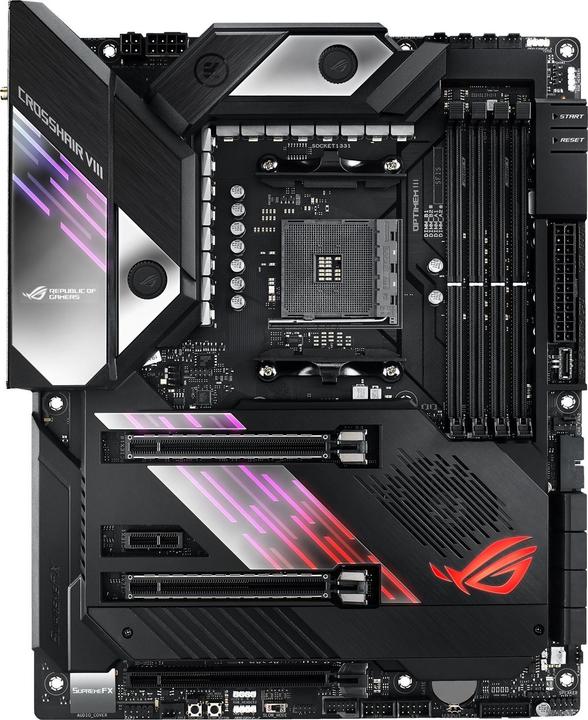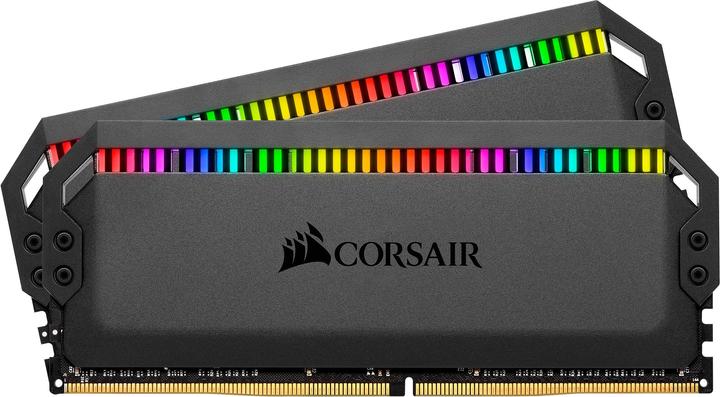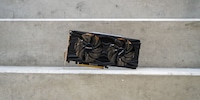

KFA2 RTX 2080 Super EX tested: What can the cheapest 2080 Super model do?
We continue with our graphics card reviews. On the programme today: the KFA2 RTX 2080 Super EX.
The 2080 Super graphics cards were released at the end of July 2019. The KFA2 model has a custom PCB and is therefore not suitable for water cooling, as no water block is available.

The card is tested on our DimasTech Easy V3.0 Benchtable with the following components:
You can read about our graphics card test methodology in the following article:
Facts and features
The TU104 chip is installed in the 2080 Super EX. The same chip is already installed in the non-super version of the 2080 and the super version of the 2070. However, more shader units and cores are activated.
| RTX 2080 FE | KFA2 RTX 2080 Super EX | |
|---|---|---|
| Chip | TU104 | TU104 |
| Shader | 2944 | 3072 |
| TMUs | 184 | 192 |
| RT-Cores | 46 | 48 |
| Tensor cores | 368 | 384 |
| GPU clock | 1515 / 1800 GHz | 1650 / 1845 GHz |
| Memory | 8GB GDDR6 | 8GB GDDR6 |
| Interface | 256 bit @ 7.75 GHz | 256 bit @ 7.75 GHz |
| ROPs | 64 | 64 |
| Board power | 225 watts | 250 watts |
With a length of 29.5 centimetres, the graphics card should fit into most midi-towers and even small form-factor cases. The card is also 5.2 cm wide and 14.3 cm long. The card is connected to the power supply with an 8-pin and a 6-pin cable. The interface is PCI Express 4.0 x16. One HDMI and three display ports are available as outputs.
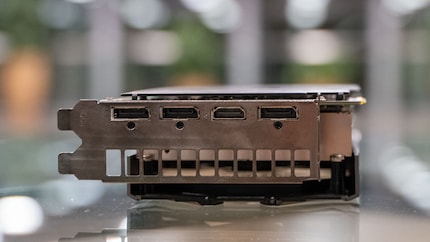
The design of the card is clearly aimed at gamers. This is evident from the "What's your Game?" lettering on the front of the card. Like the fans, this lettering is optionally illuminated by LED. LED settings are made with KFA2's Xtreme Tuner, where you have the options Static, Breathing, Rainbow, Cycle Breathing or LED Off. You can also make overclocking settings in the Xtreme Tuner.
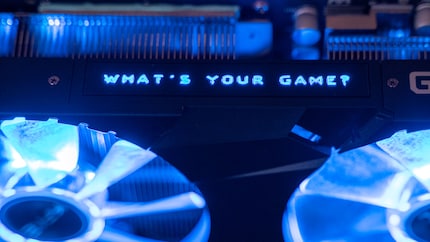
The graphics card is cooled by two 100 millimetre axial fans. According to KFA2, the two fans generate an airflow of up to 119 cubic metres per hour. To illustrate: this corresponds to a volume of 476 bathtubs. The back of the graphics card is adorned with a backplate of a similar design to the card itself.
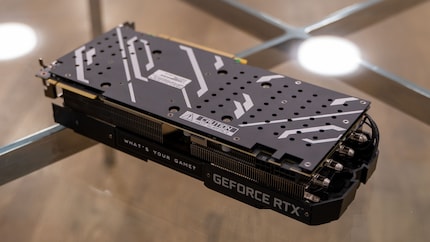
Synthetic benchmarks and temperatures
Here are the results of the Time Spy and Fire Strike benchmarks:
| Benchmark | Overall Score | Graphics Score
average FPS in Graphics Test 1 and 2 | Combined Score
average FPS |
|---|---|---|---|
| Fire Strike
(1080p, DirectX 11) | 22 467 | 26 895
130.37 FPS Test 1 106.01 FPS Test 2 | 9024
41.98 FPS |
| Fire Strike Ultra
(2160p, DirectX 11) | 6645 | 6400
36.43 FPS Test 1 22.51 FPS Test 2 | 3571
16.61 FPS |
| Time Spy
(1440p, DirectX 12) | 11 428 | 11 456
72.94 FPS Test 1 67.08 FPS Test 2 | n/a |
| Time Spy Extreme
(2160p, DirectX 12) | 5401 | 5248
33.5 FPS Test 1 30.67 FPS Test 2 | n/a |
The temperature of the KFA2 2080 Super EX rose up to 67° Celsius during the tests. On average, the temperature is 65° Celsius. Compared to the recently tested Radeon 5700 XT from Sapphire, this is very cool. The 5700 XT climbed up to 83° Celsius.
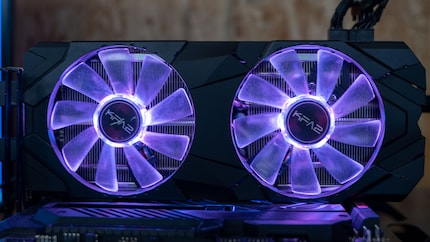
Applications
In the first graphics card review, I asked myself what influence the graphics card has on Photoshop performance. Now that I've done the second review, I can say that the graphics card has a big influence.
Puget Systems Photoshop benchmark
The Photoshop benchmark uses the following reference workstation as the basis for calculating the scores:
- Intel Core i9 9900K 8 Core
- NVIDIA GeForce RTX 2080 8GB
- 64GB of RAM
- Samsung 960 Pro 1TB
The results of the reference workstation can be used to estimate how well other systems perform. Our test benchmark with the KFA2 2080 Super EX achieves the following results:
| Scores | KFA2 RTX 2080 Super EX | Sapphire Radeon RX 5700 XT | Reference workstation |
|---|---|---|---|
| Overall Score | 913.4 | 841.4 | 1000 |
| General Score | 87.1 | 79.1 | 100 |
| Filter Score | 94 | 84.4 | 100 |
| Photomerge Score | 94.5 | 93.7 | 100 |
| GPU Score | 97.6 | 86.5 | 100 |
With 97.6 points, the 2080 Super achieves 11.1 points more than the 5700 XT. However, the graphics card has an effect on all areas, as you can see in the comparison with the 5700 XT. Where our workstation with the 5700 XT was still far behind, the difference with the 2080 Super is already much smaller. In terms of GPU score, the 2080 Super in our system comes very close to the 2080 in the reference workstation.
Puget Systems Premiere Benchmark
In contrast to the Photoshop benchmark, our test benchmark does not compete against a reference workstation. With the Premiere benchmark from Puget Systems, the score is calculated relative to the frame rate of the test videos. If the test video has an FPS of 29.97 and the system renders it at 29.97 FPS, this means 100 points. If it is only 14.98 FPS, there are also only 50 points.
The benchmark runs media in the formats 4K H.264 with 150 Mbps in 8 bit (59.94 FPS), 4K ProRes 422 16 bit (59.94 FPS) and 4K RED (59.94 FPS), testing live playback in Adobe Premiere Pro and the export. A value of 100 is the maximum for live playback, as Premiere cannot play back the media faster than specified. For export, on the other hand, over 100 points are feasible, as rendering is not limited to the FPS of the media.
In addition, ten ProRes 422 clips are provided with effects that place a heavy load on the graphics card. Puget Systems calls this 4K Heavy GPU Effects. These clips are then played back and exported in Premiere. The same exists for Heavy CPU Effects, with effects that place a heavy load on the CPU. The GPU value is particularly relevant for the graphics card reviews. The CPU values are still listed for the sake of completeness.
Here are the results in detail compared to the 5700 XT:
| Test | KFA2 RTX 2080 Super EX | Sapphire Radeon RX 5700 XT |
|---|---|---|
| 4K H.264 with 150 Mbps in 8 bit (59.94 FPS) | 56 Live Playback Score
91 Export Score | 60 Live Playback Score
91 Export Score |
| 4K ProRes 422 16 bit (59.94 FPS) | 99 Live Playback Score
93 Export Score | 100 Live Playback Score
97 Export Score |
| 4K RED (59.94 FPS) | 58 Live Playback Score
71 Export Score | 52 Live Playback Score
73 Export Score |
| 4K Heavy GPU Effects | 79 Live Playback Score
48 Export Score | 39 Live Playback Score
27 Export Score |
| 4K Heavy CPU Effects | 56 Live Playback Score
20 Export Score | 57 Live Playback Score
20 Export Score |
Interestingly, our testbench with 2080 Super usually performs slightly worse in the three formats (4K H.264, 4K ProRes 422 and 4K RED) than our testbench with 5700 XT. It is possible that the testbench scales better with 5700 XT than with the 2080 Super. However, there is a big difference in the Heavy GPU Effects: Here, the 2080 Super beats the 5700 XT by far.
Puget Systems after-effects
In the Puget Systems benchmark of After Effects, the benchmark scores are structured similarly to Photoshop. The following reference workstation serves as the basis for calculating the scores:
- Intel Core i9 9900K
- 128 GB RAM
- NVIDIA GeForce RTX 2080 8GB
The results of the reference workstation can be used to estimate how well other systems perform. Our test benchmark with the KFA2 2080 Super EX achieves the following results:
| Scores | KFA2 RTX 2080 Super EX | Sapphire Radeon RX 5700 XT | Reference workstation |
|---|---|---|---|
| Overall Score | 900 | 886 | 990 |
| Render Score | 98.3 | 94.1 | 98.7 |
| Preview Score | 92.9 | 79.5 | 99.3 |
| Tracking score | 78.7 | 92.2 | 100.2 |
The 2080 Super is clearly ahead of the 5700 XT in the render and preview score. I can't explain why it drops so much in the tracking score. I ran the benchmark again and got similar results. Perhaps you have an idea why this is the case?
Puget Systems Benchmark Resolve
The scores of the Resolve benchmark from Puget Systems are also based on a reference workstation. To determine the scores, codecs are rendered in 4K. The reference workstation is based on the following components:
- Intel Core i9 9900K
- A minimum of 32 GB RAM (not mentioned by Puget Systems)
- NVIDIA Titan RTX 24GB
In the 4K benchmark, I achieve the following results with our test benchmark and KFA2 RTX 2080 Super EX.
| KFA2 RTX 2080 Super EX | Sapphire Radeon RX 5700 XT | Reference workstation | |
|---|---|---|---|
| 4K Average Results Overall Score | 947 | 725 | 1000 |
| 4K H264 150 Mbps 8 bit Codec Average Score | 93.6 | 70.4 | 100 |
| 4K Cinema Raw Light | 96.6 | 53.4 | 100 |
| 4K ProRes 422 | 95.9 | 72.9 | 100 |
| 4K ProRes 4444 | 93.6 | 78.4 | 100 |
| 4K RED | 93.9 | 87.6 | 100 |
The 2080 Super leaves the 5700 XT far behind in the Resolve benchmark. Our test benchmark can almost keep up with the reference workstation in this configuration. A very good result.
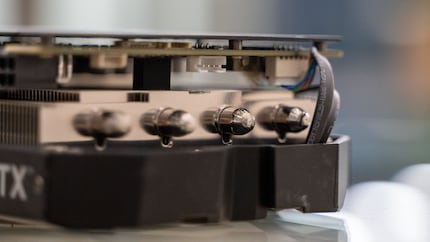
Blender
Unfortunately, I was unable to run the Blender benchmark with the KFA2 2080 Super EX. The programme crashed every time I tried. I have written to the makers of the benchmark and will post the result as soon as the problem is fixed and I can run the benchmark.
Virtual reality
When it comes to VR, I'm still looking for a programme to test games myself. Unfortunately, Nvidia's FCAT VR doesn't work for us. So here are the results from VRMark and Superposition from Unigine. These benchmarks can be used to find out whether and how well VR gaming is possible on the system in question.
| Benchmark | KFA2 RTX 2080 Super EX | Sapphire Radeon RX 5700 XT |
|---|---|---|
| VRMark Orange Room | 12 864
Points required: 5000 | 11 014
Points required: 5000 |
| VRMark Cyan Room | 11 504
Points required: 3088 | 9026
Points required: 3088 |
| VRMark Blue Room | 3687
Points required: 2972 | 2484
Points required: 2972 |
| Superposition VR Maximum
Oculus Rift | 10 000
FPS: min. 81.51, avg. 133.03, max. 186.82 | 9640
FPS: min. 87.66, avg. 108.45, max. 145.44 |
| Superposition VR Maximum
HTC Vive | 10 000
FPS: min. 86.27, avg. 144.13, max. 215.91 | 10 000
FPS: min. 96.97, avg. 122.92, max. 174.56 |
| Superposition VR Maximum
HTC Vive Pro | 10 000
FPS: min 81, avg. 132.67, max 190.23 | 9591
FPS: min 80.86, avg. 107.9, max. 145.02 |
The 5700 XT is already sufficient for current VR games. However, it is not future-proof, as evaluated by the VRMark Blue Room. The KFA2 2080 Super EX gets this label. With 3687 points, the card easily achieves the 2972 points required to be recognised as future-proof by the benchmark.
The games
Last but not least, our four game benchmarks. I'll list the average, minimum and maximum FPS. At the suggestion of user Mannyac, I'm also including the average frametime this time.
| Game | KFA2 RTX 2080 Super EX | Sapphire Radeon RX 5700 XT |
|---|---|---|
| "Crysis 3" (DX11)
FPS 1080p, highest presets | min. 50.4, average 96.7, max. 155.7
Frametime: 8-10 ms | min. 50.1, average 83, max. 134.9 |
| "Crysis 3" (DX11)
FPS 1440p, highest presets | min. 38.7, average 50.6, max. 77.5
Frametime: 18-20 ms | min. 25.4, average 38.6, max. 66.6 |
| "Crysis 3" (DX11)
FPS 2160p, highest presets | min. 22.2, average 27.8, max 37.3
Frametime: 26-28 ms | n/a |
| "Control" (DX11)
FPS 1080p, highest presets | min. 56.4, average 108.5, max. 124.7
Frametime: 8-10 ms | min. 25.6, average 55.9, max. 84.1 |
| "Control (DX11)
FPS 1440p, highest presets | min. 50.7, average 55.5, max. 63.2
Frametime: 17-19 ms | min. 28.7, average 37.2, max. 60.9 |
| "Control" (DX11)
FPS 2160p, highest presets | min. 31.2, average 34.7, max. 401
Frametime: 32-34 ms | n/a |
| "Control (DX12)
FPS 1080p, highest presets, raytracing maximum | min. 52.5, average 58.4, max. 66.9
Frametime: 16-18 ms | n/a |
| "Control (DX12)
FPS 1440p, highest presets, raytracing maximum | min. 23.4, average 31.9, max. 62.4
Frametime: 30-32 ms | n/a |
| "Control" (DX12)
FPS 2160p, highest presets, ray tracing maximum | min. 17.3, average 19.8, max. 47.4
Frametime: 34-36 ms | n/a |
| "Shadow of the Tomb Raider" (DX12)
FPS 1080p, highest presets | min. 96.4, average 122.4, max. 180.4
Frametime: 7-9 ms | min. 87, average 115, max. 183 |
| "Shadow of Tomb Raider (DX12)
FPS 1440p, highest presets | min. 63.2, average 81.4, max. 97.4
Frametime: 14-16 ms | min. 48, average 61, max. 88 |
| "Shadow of Tomb Raider" (DX12)
FPS 2160p, highest presets | min. 50.2, average 57.3, max. 68.7
Frametime: 17-19 ms | n/a |
| "Strange Brigade" (Vulkan)
FPS 1080p, highest presets | min. 177.5, average 263.1, max. 311.7
Frametime: 4-6 ms | min. 143, average 184, max. 229 |
| "Strange Brigade" (Vulkan)
FPS 1440p, highest presets | min. 108.4, average 123.7, max. 147.8
Frametime: 7-9 ms | min. 81.7, average 102, max. 239 |
| "Strange Brigade" (volcano)¨
FPS 2160p, highest presets | min. 84.8, average 96.1, max 114.8
Frametime 10-12 ms | n/a |
As expected, the KFA2 RTX 2080 Super is faster across the board than the Sapphire Radeon RX 5700 XT. The difference is smaller at 1080p than at 1440p. This is because the GPU performs more computing tasks at 1440p than at 1080p. At 1080p, the CPU also takes over some of the computing tasks.
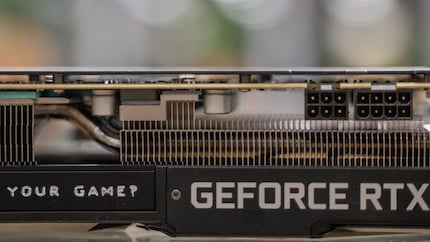
Conclusion
The KFA2 RTX 2080 EX Super is a solid high-end card. It delivers good results out of the box. Thanks to the large heat sink, the card cools efficiently. In terms of our testing methodology, I'm becoming more and more aware that I need to look for a way to test graphics cards normalised by volume. That way I can make more informed statements about cooling performance. Despite the open-plan office, the KFA2 RTX 2080 Super EX never became unpleasantly loud, which it certainly could: Just for fun, I turned the fans up to 100 per cent and then they roared properly. Let's see what we can do for future reviews. Otherwise, I'll drag the testbench into a quiet meeting room to normalise it; once I've normalised the volume, I can then test it again in its usual place.
From big data to big brother, Cyborgs to Sci-Fi. All aspects of technology and society fascinate me.
